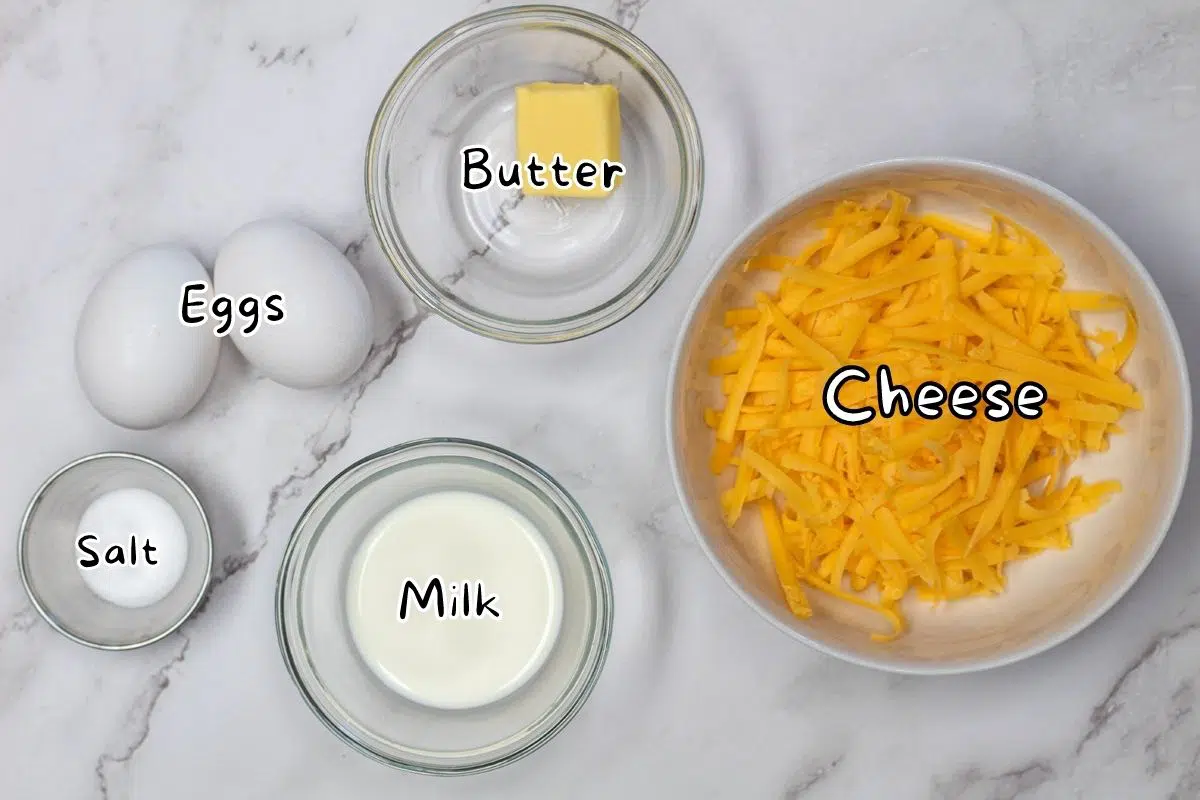This savory cheese omelet is the easiest comfort food you can make, and it's a family favorite for breakfast, brunch, or dinner! Eggs are beaten and cooked just enough to be wonderfully tender, then filled with melty cheese!
Serve with favorites like French toast sticks, cinnamon rolls, hash browns, or corned beef hash.

Jump to:
The simplicity of making a classic cheese omelet is perfect for both beginners and seasoned cooks. This easy-to-make recipe requires just a few basic ingredients, likely already in your kitchen, making it ideal for a quick breakfast, brunch, or dinner.
It's a great source of protein and allows you to experiment with different fillings and toppings.
Whether you're serving it to kids or adults, its warm, cheesy flavor is sure to be a hit, fitting seamlessly into any meal plan as a vegetarian and gluten-free option.
🥘 Ingredients
This quick and easy omelet is made with only four ingredients that you probably keep stocked in your kitchen all the time. That means no last-minute grocery shopping!

- Eggs - The textbook foundation of any omelet. Set them on the counter ahead of time so they can come up to room temperature.
- Salt - A small amount to your preference.
- Milk (optional) - Or use water, if desired.
- Butter (or cooking oil- see notes) – Melted in the skillet for extra flavor. Remember to use less salt if using salted butter.
- Cheddar cheese - A sharp cheddar pairs perfectly with fluffy, warm eggs, but you can try other cheeses as well! Freshly grated cheese will melt better than the pre-shredded, but either will get the job done.
- Additional toppings (optional) - Try adding some salsa on top for a kick or some caramelized onions for a heartier dish. The possibilities are limitless!
*Be sure to see the free printable recipe card below for ingredients, exact amounts & instructions with tips!*
📖 Variations
- Bacon & Cheese – Chop up some crisped bacon and add it to your filling and/or toppings for a savory breakfast omelet.
- Ham & Cheese – Pan-fry diced ham for a tasty addition to your omelet. (The perfect way to use up holiday leftovers!)
- Mushroom & Swiss – Sautéed mushrooms add a deep, rich flavor to the eggs.
- Veggie & Cheese – Adding your favorite vegetables will make this healthy omelet even more filling. Try mixing in some cooked bell pepper, tomatoes, or spinach-- you name it.
- Chili Omelet – Top your cheese omelet with a hearty serving of chili!
- California Omelet – For a fresh take using traditionally California-grown ingredients, like avocado, tomatoes, cheese, and bacon, try this delicious California omelet recipe.
🔪 How To Make A Cheese Omelet
The great thing about a cheese omelet is it takes very little prep (it also takes very little skill)! Follow these simple instructions to make an omelet like a pro.
This recipe will make a single cheese omelet. If you are cooking for others, just repeat the recipe per person.








- Prep. In a bowl, combine the 3 large eggs with salt, 1 tablespoon milk or water (optional), and whisk or blend with a fork. Then heat a 9-inch non-stick skillet to medium heat and melt 1 teaspoon of butter (or use oil or a combination of oil and butter), spreading to coat the entire skillet bottom.
- Cook. Pour the eggs into the center of your heated skillet and lift the handle (tilting) to spread the egg mixture out toward the skillet edge. Once the eggs begin to firm up, use a spatula to lift the edges and tilt the remaining uncooked egg toward the edges. *Also, break any bubbles that are forming and fill them with the uncooked egg as well.
- Fill, fold, and finish. Leave the omelet to set and cook fully for about 10-15 seconds after filling the gaps and rounding out the edges. Then, fill with half of the grated cheddar cheese. Using a spatula, flip the first edge inward over the filling to the opposite edge and close the omelet.
- Serve. Slide the cooked omelet onto a plate and finish topping with the remaining half of the cheese. Add any other condiments desired and serve immediately.
Omelets also make for a great lunch, or you can pair it with a salad for a well-rounded meal at dinnertime! See my post on what to serve with an omelet for ideas.

💭 Angela's Pro Tips & Recipe Notes
- Cooking Oil Instead of Butter: Use cooking oil for high-heat cooking without the risk of burning. Peanut oil is ideal, but olive or coconut oil is also a good alternative. This will help you achieve a restaurant-quality omelet.
- Room Temperature Eggs: Use eggs at room temperature for even cooking. Cold eggs can slow down the cooking process and lead to uneven results.
- Quickly Warming Cold Eggs: If your eggs are still in the fridge, place them in a bowl of lukewarm water for about 5 minutes. This is also a great time to prepare any additional fillings or toppings.
- Adding Pepper at the End: To avoid discoloring the eggs, add pepper after the omelet is cooked, not during.
- Attentive Cooking: Omelets cook quickly, so don't leave the pan unattended. Continuously tilt and lift the skillet to ensure even cooking.
- Avoid Overcooking: Remember that eggs continue to cook even after being removed from heat. Remove the omelet from the skillet when it's no longer runny.
- Cheese Choice: Opt for block cheese that you grate over pre-packaged shredded cheese. Prepackaged cheese contains additives that can affect melting quality.
>>>>See all of my recipes here<<<<
❓ Recipe FAQs
Of course you can! Adding water to your eggs can make the omelet nice and airy. Add just ½ a teaspoon per egg before pouring them into the pan. The heat from the skillet will create steam while the eggs cook and make your omelet extra fluffy! This method works best when cooking with oil or an oil and butter mixture at high heat.
Yes! If you use a skillet that is too large, the eggs will be spread thin, creating a flatter omelet. A skillet that is too small will cause the omelet to be very thick; the outside will cook before the inside, and it will be difficult to fold. It is best to use an 8-inch skillet for a 2-egg omelet and a 9-inch skillet for a 3-egg omelet.
As previously mentioned, a mixed greens salad goes great with an omelet at lunch or dinner. Traditionally, hash browns make a filling side dish at breakfast time. An omelet goes with almost anything! Try some fruit on the side for a healthier meal or a toasted English muffin. It can also be a meal in itself.

🍳 Other Breakfast Recipes
- Hash Brown Sausage & Egg Casserole
- Breakfast Sandwiches
- Avocado Egg Bake
- Bisquick Pancakes
- Air Fried Country Fried Steak & Country Gravy
- Skillet Potatoes & Onions
Do you love a recipe you tried? Please leave a 5-star 🌟rating in the recipe card below and/or a review in the comments section further down the page.
Stay in touch with me through social media @ Pinterest, Facebook, Instagram, or Twitter! Subscribe to the newsletter today (no spam, I promise)! Don't forget to tag me when you try one of my recipes!
📖 Recipe Card
Cheese Omelet
Ingredients
- 3 large eggs (at room temperature)
- ⅛ teaspoon salt (to taste)
- 1 teaspoon butter (or cooking oil - see notes)
- ½ cup cheddar cheese (grated)
- 1 tablespoon milk (or use water - both are optional)
(Note: 2x or 3x only changes the ingredient list)
Instructions
- In a bowl, combine the 3 large eggs with ⅛ teaspoon salt, optional 1 tablespoon milk or water, and whisk or blend with a fork.
- Heat a 9-inch non-stick skillet to medium heat and melt the 1 teaspoon butter (or use oil, or a combination of oil and butter), spreading to coat the entire skillet bottom.
- Pour the beaten eggs into the center of your heated skillet and lift the handle to tilt the pan, and spread the egg mixture out toward the skillet edge. Once the eggs begin to firm up, use a spatula to lift the edges, and tilt the remaining uncooked egg toward the edges. *Also, break any bubbles that are forming and fill them with the uncooked egg as well.
- Let the omelet cook for about 10-15 seconds after filling any gaps and rounding out the edges. Then fill with half of the grated ½ cup cheddar cheese. Use a spatula to flip the first edge inward over the filling, then the opposite edge to close the omelet.
- Slide the cooked omelet onto a plate and finish topping with the remaining half of the cheese. Add any other condiments desired, serve, and enjoy!
Notes
- For the best results when cooking an omelet, start with room-temperature eggs.
- For an omelet that tastes like your favorite restaurant version, try using peanut oil rather than butter. I've found this to yield my favorite omelets (of any flavor!).
- Your eggs continue cooking after removing the omelet from the pan, they are ready to serve once the eggs are no longer runny when you lift and tilt your skillet.



Comments
No Comments